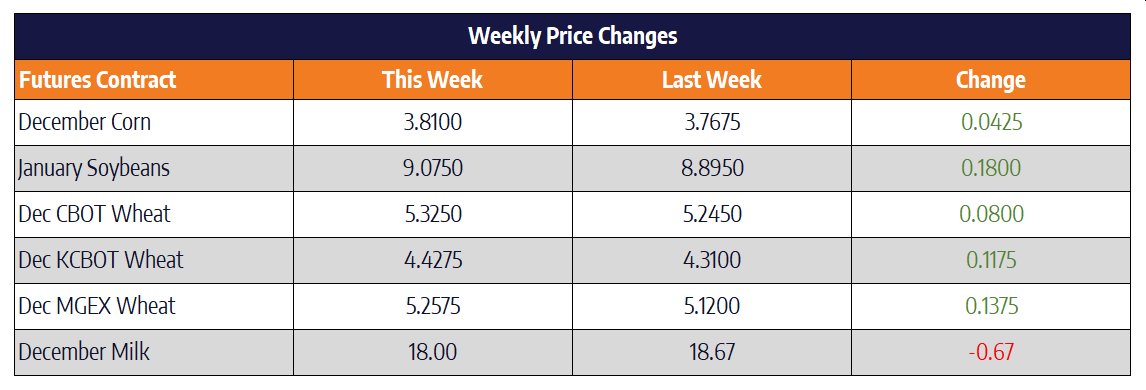Corn trades higher as harvest drags on for some
After trading to new lows on Wednesday, the corn market had a strong finish to the week, technically speaking. March corn settled this week at 381, up 4-1/4 cents. July corn had its best week in two months, trading 7 cents higher to close at 393-3/4. Ethanol production has been on a steady increase for the last 10 weeks since bottoming in late September. Ethanol profit margins have stayed positive for most of the last few months after a long summer of negative profit margins. Expensive corn and lowered ethanol demand hurt the industry during the early summer of 2019. The EPA looks to be drafting legislation that will improve overall ethanol demand from recent years. The near-term future of the ethanol industry looks to be favorable. On Thursday the USDA announced Mexico had bought a large amount of corn, over 63 million bushels in total. With cattle on feed numbers higher than a year ago overall corn export and domestic demand look to be on the rise.
The final USDA crop progress report for the 2019 crop year was released Monday. Corn harvest was seen as 92% complete across the country as of December 8. The most alarming state was North Dakota with only 43% of their corn harvest completed. Not only have fields been waterlogged in that part of the country, but any corn that has been harvested has generally had poor test weights and high moisture. For perspective, North Dakota accounted for less than five percent of the national corn crop in recent years. But, the struggle to harvest this less than average crop has been a common theme across the Northern corn belt.
Soybean market moves higher on trade optimism
Front month beans added 18 cents this week to close at 907-1/2. January soybeans have now improved 30 cents in the last two weeks. November soybeans were also higher, closing at 951 up 13-1/2 cents on the week. The world’s number three exporter of soybeans, Argentina, has been dry in recent weeks to start out their growing season. Forecasts call for rains in the near future, but the market will keep a close eye on South American weather as a whole moving into the new year and beyond.
On the trade front, rhetoric seems to be steadily improving as both the US and China announced Friday that a Phase One Deal has been struck. President Trump tweeted early Friday “We have agreed to a very large Phase One Deal with China. They have agreed to many structural changes and massive purchases of Agricultural Product, Energy, and Manufactured Goods, plus much more. The 25% Tariffs will remain as is, with 7 1/2% put on much of the remainder. The Penalty Tariffs set for December 15th will not be charged because of the fact that we made the deal. We will begin negotiations on the Phase Two Deal immediately, rather than waiting until after the 2020 Election. This is an amazing deal for all. Thank you!” Chinese officials shortly after stated “the value of U.S. farm good purchases will be disclosed at a later date.” The vagueness of the agreement settled January soybean futures 6-3/4 cents, off of their high for the day on Friday.
Wheat moves slightly higher
March Chicago wheat was up 8 cents on the week to close at 532-1/2. March Kansas City wheat was up 11-3/4 cents to finish at 442-3/4. March Minneapolis spring wheat was up 13-3/4 cents this week to settle at 525-3/4, its highest close in a month. The March Chicago wheat chart traded down to and tested but held the 10-week moving average this week. The USDA improved their wheat export estimate 25 million bushels on Tuesday’s Supply and Demand report. A dry forecast for the Plains plus talk of a smaller European crop in 2020 also helped support the market this week. Also, yields are expected to be the lowest in more than 10 years in Australia after a massive drought. Overall world wheat stocks are on the decline. With details of a trade deal on the horizon wheat may follow other grains higher.
Spot Barrel Prices Finish the Week Over 50 Cents Lower
Today closes out one of the worst weeks for the block/barrel averages in the history of the CME spot trade closing 35.25 cents lower. This move down was led by barrels losing 53.25 cents on the week, while blocks lost 17.25 cents. Today barrels dropped 6.5 cents lower on 8 loads traded, while blocks dropped 6 cents lower on no loads traded. The whey market also traded lower today on what appears to be a potential false breakout over the $0.35/lb level closing the week at $0.3375/lb. Butter futures were the only product on the CME with a net gain this week gaining 4.5 cents on the week and 0.5 cents today. Non-fat powder was just slightly lower on the week at 0.25 cents lower after trading 0.75 cents higher today. Prices remain near the 2019 high in the spot market.
Futures continue to drift lower as the spot cheese market gets hammered down. The futures market has been anticipating this move for a while, but it probably wasn’t expected such a drastic move. Prices in early 2020 contracts were unable to hold onto 2020 gains with the January contract retesting the $18.00 level today. This is an area of support we have bounced off of before back in September. While we have traded short term trend to “down” recently we are keeping long term trend to “up”.


